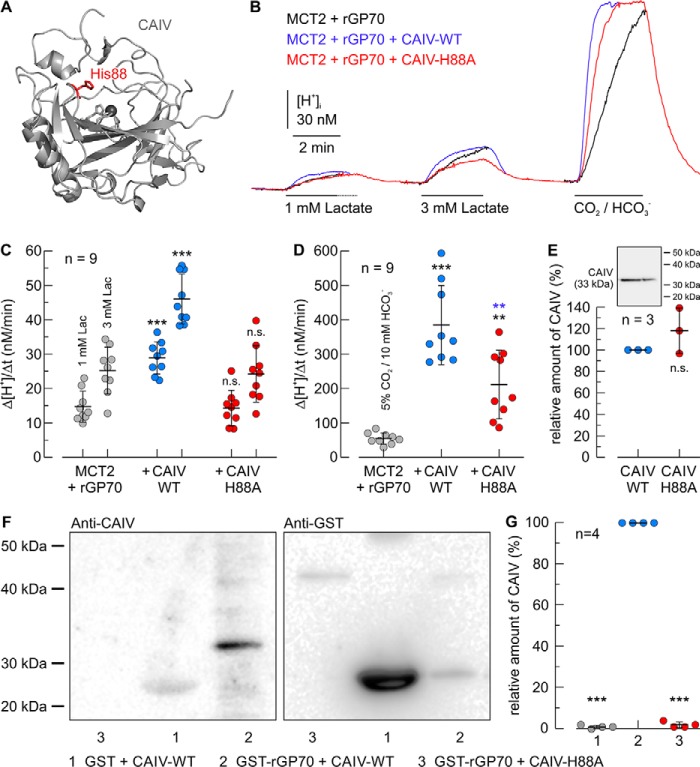Figure 7.
Functional interaction between rat MCT2 and CAIV in Xenopus oocytes requires direct binding of rGP70 to His-88 in CAIV. A, structure of human CAIV (PDB code 5JN9 (79). The amino acid residue His-88 is labeled in red. B, original recordings of the change in intracellular H+ concentration during application of lactate and CO2/HCO3− in Xenopus oocytes, expressing rMCT2 + rGP70 alone (black trace), together with human CAIV–WT (blue trace), or together with the CAIV mutant H88A. C and D, rate of change in intracellular H+ concentration (Δ[H+]/Δt) during application of lactate (C) and 5% CO2, 10 mm HCO3− (D) in Xenopus oocytes, expressing rMCT2 + rGP70–WT (gray dots), rMCT2 + rGP70–WT + CAIV–WT (blue dots), and rMCT2 + rGP70–WT + CAIV–H88A (red dots), respectively. The black significance indicators above the dots with CAIV refer to the corresponding dots without CAIV (gray dots). The blue significance indicators above the dots for CAIV–H88A refer to the corresponding dots with CAIV–WT (blue dots). E, relative amount of CAIV in CAIV–WT- and CAIV–H88A–expressing oocytes, as determined by Western blot analysis. The inset shows a representative Western blotting against CAIV for Xenopus oocytes expressing CAIV–WT (left lane) and CAIV–H88A (right lane), respectively. F, representative Western blots of CAIV (left blot) and GST (right blot), respectively. CAIV–WT was pulled down with GST (lane 1), and a GST fusion protein of the Ig1 domain of rGP70–WT (lane 2). The mutant CAIV–H88A was pulled down with a GST fusion protein of the Ig1 domain of rGP70–WT (lane 3). Lanes 1 and 2 in the blots are identical to lanes 1 and 2 in Fig. 8D. G, relative intensity of the fluorescent signal of CAIV. For every blot, the signals for CAIV were normalized to the corresponding signals for GST–rGP70 + CAIV–WT. Each individual signal for CAIV was normalized to the intensity of the signal for GST in the same lane. The significance indicators above the dots refer to GST–rGP70 + CAIV–WT.

